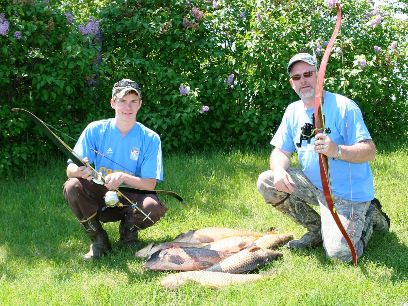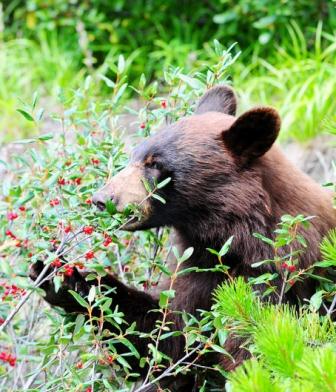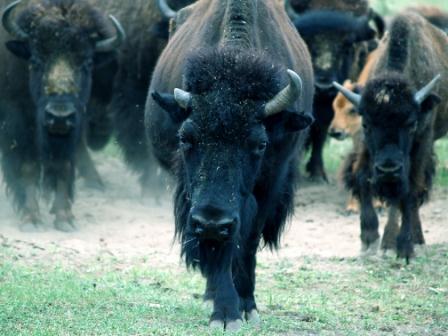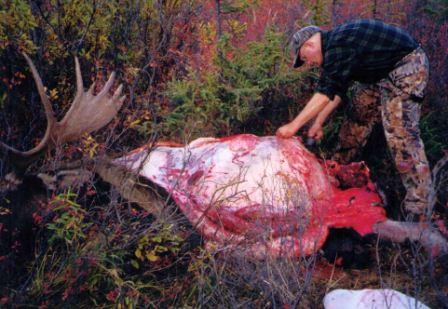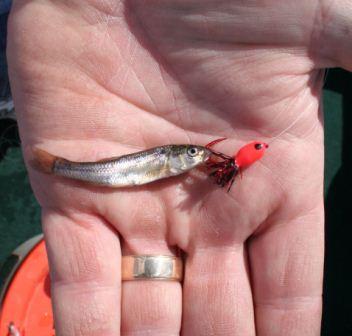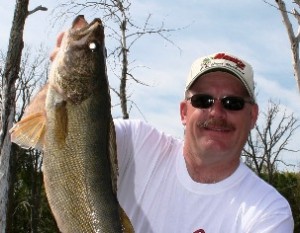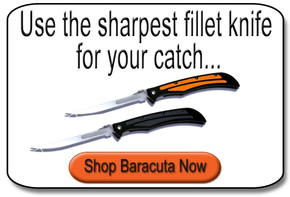By Bernie Barringer
For Spring and Summer Fun…
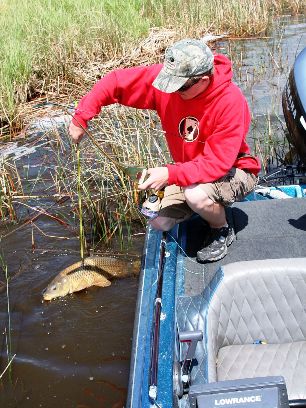
Carp shooting can be a challenge. Here the author’s son Dawson examines the result of a successful shot.
Bowfishing equipment has evolved a lot since I started 40 years ago. In light of all the high-tech stuff out there I may sound crazy, but my favorite bowfishing set-up features a Ben Pearson recurve I picked out of the “Free” box at a garage sale.
No kidding.
Between that and the high-tech stuff out there, you can make bowfishing as simple or as complicated as you want, and anyone can easily get started. That’s why bowfishing is so great. Shots are close, rarely over 25 feet, and a bow of just about any draw length or poundage
will do.
You need to choose locations with stealth, and know the trick to being a good shot. It takes beginning bowfishers a while to get used to “shooting where they ain’t”. Because light refracts as it enters the water, fish appear to be a lot nearer the surface than they actually are. So when you see a carp cruising the shallows, you must aim well below it if your arrow is to hit its mark.
Getting Started

Bowfishing can be complicated or simple. Sometimes wading can be as productive as shooting from a boat. You can clearly see the modified fishing reel mounted on Dawson’s bow.
My 45-pound recurve is perfect for me. You can use a compound bow with a let-off, but they have to be drawn all the way back to shoot, putting you at a disadvantage taking quick shots. Wheel-bows made especially for bowfishing don’t have a let-off so you can draw smoothly and shoot without coming to full draw.
Arrows should be solid fiberglass, they have the sturdiness needed to take a pounding from hitting bottom. The extra weight gives them plenty of kinetic energy to penetrate the water and then the fish. All bowfishing tip designs have one primary feature: some sort of prongs to keep them from pulling out of the fish – prongs which can be reversed so you can remove the arrow from the fish once you get it reeled in.
My first reel was a simple spool with hand-wound line. Now I have a reel with a small crank that pulls all the line into a plastic jar, a set-up that really works slick. My son Dawson uses a modified fishing reel that attaches to a mount on his bow. Simple spool reels are about $20 and the one I use is over $100. Higher prices buy more convenience.
Where to Find Huntable Fish
Many species of fish are legal to shoot with a bow. Carp, bowfin (some call them dogfish), gar, buffalo and drum are among the most common. Being in the right place at the right time always brings success, but consistent action takes place in spring and early summer.
For the best spots, find the warmest water. When the water warms up in late spring, carp move shallow to spawn. In most areas, near 70 degrees will produce action. In the upperMidwest, that’s usually late April to May. Here in northern Minnesota, it’s a bit later, and we had some fantastic carp shooting during the first week of June at Lake Manitoba in Canada while on a spring bear hunt. In most places you’re looking for a window of opportunity of two weeks or less, but carp may remain shallow and vulnerable to bowfishing for almost a month. When you hit it right, the action can be furious.
Later in summer, a second window of opportunity opens. Carp are again found in shallow, warm water where they slurp plants off the surface and cruise for insects and dead baitfish. You are often shooting at their heads, which might be the only thing visible in muddy water. I’ve also seen pods of carp cruising shallow bays of clear-water lakes, and have enjoyed good shooting under those mid-summer conditions, too.
Shooting Takes Practice

A cooler full of carp has many uses. It can be used as trapping bait, bear bait, and some people even smoke it or pickle it.
Typically, I shoot from the front of a boat with an electric trolling motor quietly pulling me through the shallows. I also have a ball shooting while slowly walking the back bays where the water is warm. The carp are often lying just below the surface, sunning themselves. That’s when they’re extremely spooky, so use a stealthy approach.
Shots will generally be short. A 10-yard shot is a very long shot in bowfishing; the majority will be 10-15 feet. It takes practice to hit a target that close. Most bowhunters do not practice 10-foot shots, but it is a good idea to do so before you go after carp.
I cannot stress too much that the refraction of the light on the water makes the target look closer to the surface than it actually is, so you have to shoot below them to hit them. This is one thing that must become second nature, and you’ll miss a few fish until you get it. My son Dawson missed his first nine shots one day before getting it dialed in. Then he hit his next five in a row!
Carp shooting is so much fun that it has become a sport in itself for our family. Give it a try, and see if you don’t get hooked like we did!
***
About Bernie Barringer:
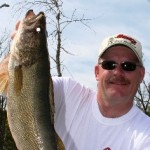 Bernie Barringer is a lifelong angler enjoys fishing for all species and writing about his experiences for many outdoor magazines.
Bernie Barringer is a lifelong angler enjoys fishing for all species and writing about his experiences for many outdoor magazines.
For more articles by Bernie, click here,
and for the best fillet knife, click here.
13,015 total views, 1 views today


